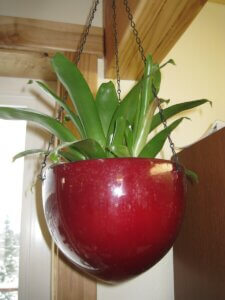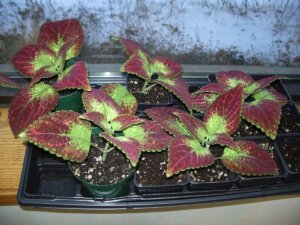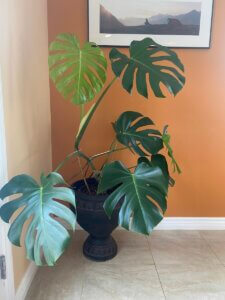By Heidi Rader, Professor of Extension at University of Alaska Fairbanks.
 If you know me, then you know this article is actually just an excuse to brag about the fig … tree … in my office. Yes, it produces figs, even in the winter, which I love. No, I do not have an army of wasps living in my office to pollinate the figs, but that doesn’t seem to matter. OK, sorry, back to houseplants. I will try to stop talking about my fig, which, if you come into my office, you can see is hard to ignore.
If you know me, then you know this article is actually just an excuse to brag about the fig … tree … in my office. Yes, it produces figs, even in the winter, which I love. No, I do not have an army of wasps living in my office to pollinate the figs, but that doesn’t seem to matter. OK, sorry, back to houseplants. I will try to stop talking about my fig, which, if you come into my office, you can see is hard to ignore.
The key to growing thriving houseplants is choosing a plant suitable for your indoor conditions and ensuring the plant is potted in an appropriately sized pot with suitable soil, while providing, if not ideal, at least tolerable conditions in terms of humidity, light, and water. Hopefully, you like the look of the plant, as well. Some plants almost do too well, and then space becomes an issue, but you can always cut them back and propagate the cuttings. By the way, plants make great gifts and many are easily propagated. You can also sell them online.
For many plants, the naturally dry and dark winters in Interior Alaska are less than ideal. The Cold Climate Housing Research Center (https://cchrc.org/ventilation-overview/) recommends keeping your house at 30-40% relative humidity. Higher than 40% can lead to problems with mold and condensation and 60% and higher promotes bacterial, viral and fungal growth. Note that using a wood stove can lower your humidity levels even more than average. Humidity could be increased with a humidifier, but that could cause other indoor air health issues.
Although many plants can thrive in drier conditions, orchids and other epiphytes do best with humidity between 40-70% because they absorb water through their leaves. Most pitcher plants prefer 50-80% relative humidity.
and other epiphytes do best with humidity between 40-70% because they absorb water through their leaves. Most pitcher plants prefer 50-80% relative humidity.
Light can be increased inexpensively with LED lights. Meriam Karlsson, horticulture professor at the University of Alaska Fairbanks, researches how plants respond to the type, intensity and timing of light, among other things. She offers a robust discussion of light choices and ideal light conditions for various plants in the publication Controlling the Greenhouse Environment: https://www.uaf.edu/ces/publications/database/gardening/controlling-greenhouse-environment.php.
Houseplants can be categorized by how easy they are to grow: easy, average or difficult. My daughter counted our houseplants and found that we had 48. However, many more have died, so there has been a bit of trial and error involved.
Hoya (also known as wax plant) is perhaps my oldest and easiest houseplant to grow. I got a cutting about 20 years ago. That cutting has made many other cuttings, one of which I got back when my cabin froze. I have taken it to various villages when I travel for workshops, and I have gifted it to people who say they have a black thumb. They have managed to keep it alive, so I think it’s safe to say that it’s one of the easiest houseplants to grow. It has become a living wall in my sister’s yurt. Spider plants are also very easy to grow and propagate, but I don’t like how they look. Cactuses are pretty easy to grow, but absolutely no fun to transplant.
easiest houseplant to grow. I got a cutting about 20 years ago. That cutting has made many other cuttings, one of which I got back when my cabin froze. I have taken it to various villages when I travel for workshops, and I have gifted it to people who say they have a black thumb. They have managed to keep it alive, so I think it’s safe to say that it’s one of the easiest houseplants to grow. It has become a living wall in my sister’s yurt. Spider plants are also very easy to grow and propagate, but I don’t like how they look. Cactuses are pretty easy to grow, but absolutely no fun to transplant.
Monstera, ficus and jade are other tried-and-true houseplants, although I have had a fungus kill large jade plants several times, which has been frustrating. I also love my Christmas cactus, or as I call it, my birthday cactus, because it bloomed on my birthday in October and my mom’s birthday in April.
I’ve found jasmine, pitcher plants, orchids and bromeliads to be difficult to grow. I should say I can usually keep the plants alive, but it has been difficult to encourage them to bloom or produce pitchers. I found it hard to keep jasmine alive, but I kept trying because there is nothing better than the smell.
I tend to choose large pots and avoid anything that requires watering more than once every two weeks. Generally, I only water about once a month for the most part, maybe a bit more in the heat of the summer. I like the plastic pots with no holes in the bottom and a plastic insert that allows water to pool at the bottom. This keeps the mess down. It gives you a bit more buffer in terms of watering time and aids healthy roots because they’re not sitting in water.
watering more than once every two weeks. Generally, I only water about once a month for the most part, maybe a bit more in the heat of the summer. I like the plastic pots with no holes in the bottom and a plastic insert that allows water to pool at the bottom. This keeps the mess down. It gives you a bit more buffer in terms of watering time and aids healthy roots because they’re not sitting in water.
I’ve had issues with terracotta pots indoors leaving mold on whatever furniture they’re on. If you have a very small pot, then you end up having to pay closer attention to watering them. Most of the plants I have can go two weeks to a month without being watered. Pots with a plant insert basically have access to water as needed. But the fig is a different situation. The fig usually needs three gallons of water every five days, especially in the summer.
The main issue I’ve had is fungus gnats. I use sticky traps for them and try not to overwater. But I’m also trying to train my kids to water the right amount for their houseplants, so it is a challenge! If I bring my tomatoes or herbs in from the garden to extend the season, I get a lot of aphids.
them and try not to overwater. But I’m also trying to train my kids to water the right amount for their houseplants, so it is a challenge! If I bring my tomatoes or herbs in from the garden to extend the season, I get a lot of aphids.
Other common pests include mealybugs, scale insects, whiteflies, spider mites, thrips and cyclamen mites. For help in identifying pests and diseases, check out the University of Alaska Fairbanks Extension’s Houseplant Pests and Control publication: https://www.uaf.edu/ces/publications/database/insects-pests/houseplant-pests.php. You can also submit a question to Extension through Ask an Expert: https://www.uaf.edu/ces/askextension/index.php
Getting to know your plant is essential to keeping it thriving. How often does it need to be watered, depending on the season? What, if any, pests or diseases are present and how can you control them? What’s the ideal soil? What is the ideal fertilizer regime? Does it require higher than average humidity or light (or a special type of light to spur flowering or fruiting)? What location in your house does it prefer, i.e., in the bathroom, by a south-facing window, etc? What size pot do you need and does it need to be repotted? Will a pot with holes or one with an insert and no holes work?
Particularly if you have pets or children in the home, is it poisonous?
The following resources can help you answer these questions and learn more about different plants you might want to grow.
and learn more about different plants you might want to grow.
- Selection and Care of Indoor Plants
https://extension.umd.edu/resources/yard-garden/indoor-plants/selection-and-care-indoor-plants/ - University of Vermont Master Gardener Resources for Houseplants:
https://www.uvm.edu/extension/mastergardener/gardening-resources#:~:text=Houseplant%20Hero%20Video%20Series%20with%20UVM%20Extension,aired%20on%20Across%20the%20Fence%2C%20April%202023
Heidi Rader is a professor of Extension and project director for the Alaska Tribes Extension Project. This work is supported by the Federally Recognized Tribes Extension Program Project 2022-41580-37957. It is a partnership with the Tanana Chiefs Conference. Any opinions, findings, conclusions, or recommendations expressed in this publication are those of the author(s) and do not necessarily reflect the view of the U.S. Department of Agriculture.
The University of Alaska (http://www.alaska.edu/alaska) is an equal opportunity/equal access employer and educational institution. The university is committed to a policy of nondiscrimination (http://www.alaska.edu/nondiscrimination) against individuals on the basis of any legally protected status.
